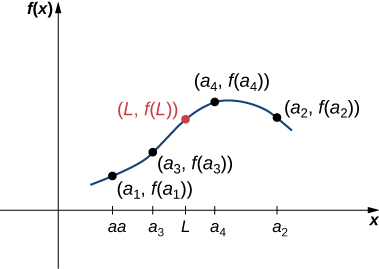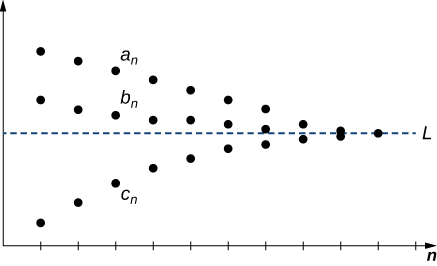| << Chapter < Page | Chapter >> Page > |
Consider a sequence and suppose there exists a real number such that the sequence converges to Suppose is a continuous function at Then there exists an integer such that is defined at all values for and the sequence converges to ( [link] ).
Let Since is continuous at there exists such that if Since the sequence converges to there exists such that for all Therefore, for all which implies We conclude that the sequence converges to
□

Determine whether the sequence converges. If it converges, find its limit.
Since the sequence converges to and is continuous at we can conclude that the sequence converges and
Determine if the sequence converges. If it converges, find its limit.
The sequence converges, and its limit is
Another theorem involving limits of sequences is an extension of the Squeeze Theorem for limits discussed in Introduction to Limits .
Consider sequences and Suppose there exists an integer such that
If there exists a real number such that
then converges and ( [link] ).
Let Since the sequence converges to there exists an integer such that for all Similarly, since converges to there exists an integer such that for all By assumption, there exists an integer such that for all Let be the largest of and We must show that for all For all
Therefore, and we conclude that for all and we conclude that the sequence converges to
□

Use the Squeeze Theorem to find the limit of each of the following sequences.
Using the idea from [link] b. we conclude that for any real number such that If the sequence diverges because the terms oscillate and become arbitrarily large in magnitude. If the sequence diverges, as discussed earlier. Here is a summary of the properties for geometric sequences.
We now turn our attention to one of the most important theorems involving sequences: the Monotone Convergence Theorem. Before stating the theorem, we need to introduce some terminology and motivation. We begin by defining what it means for a sequence to be bounded.

Notification Switch
Would you like to follow the 'Calculus volume 2' conversation and receive update notifications?